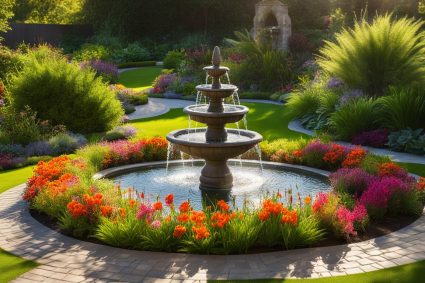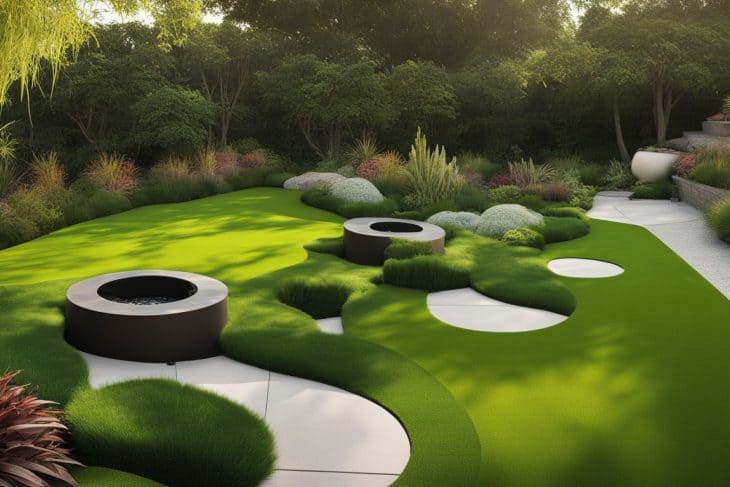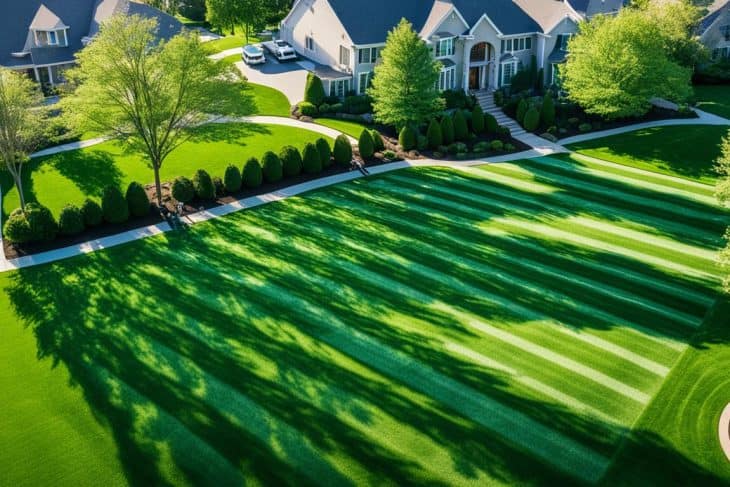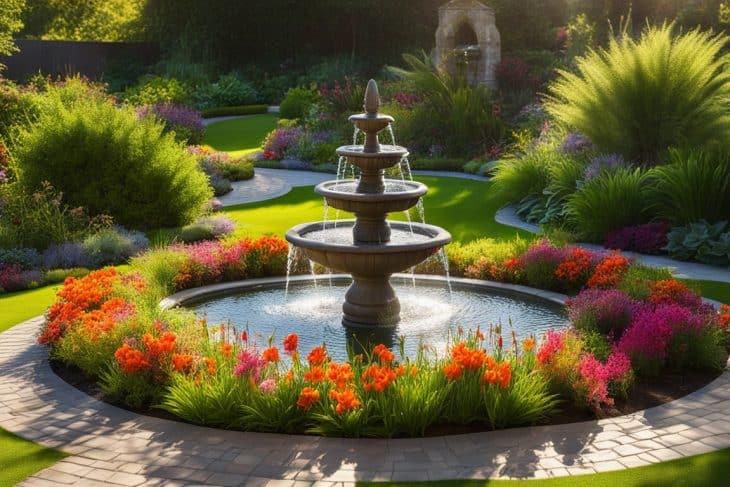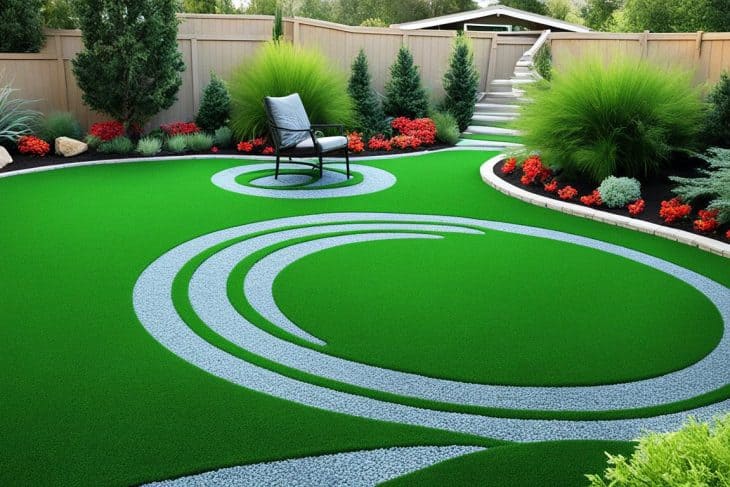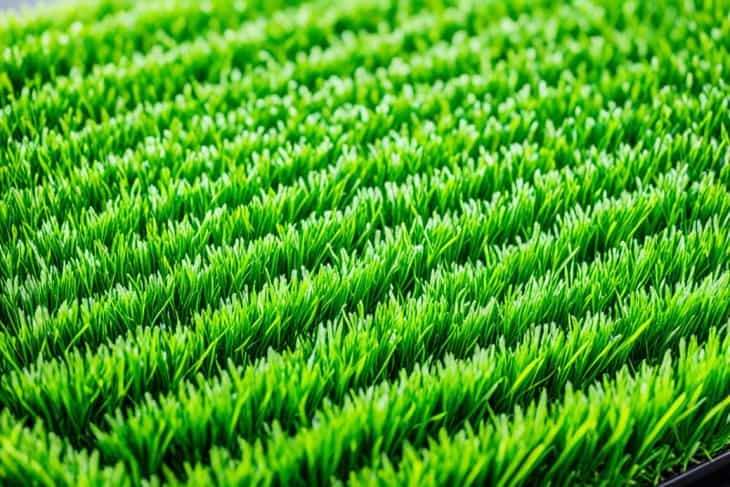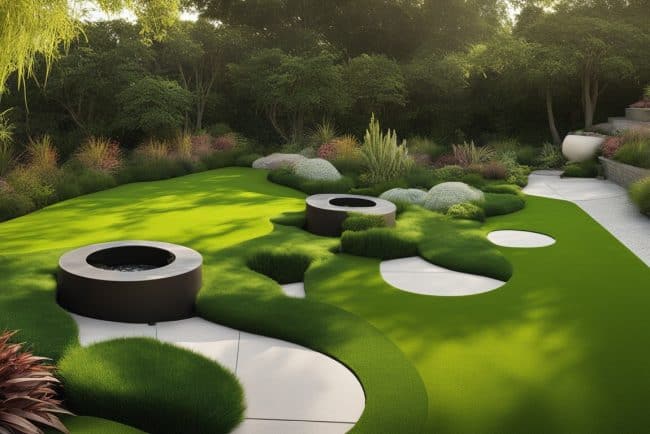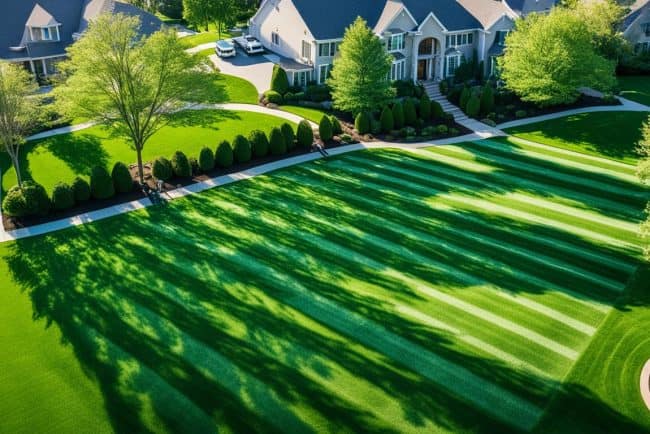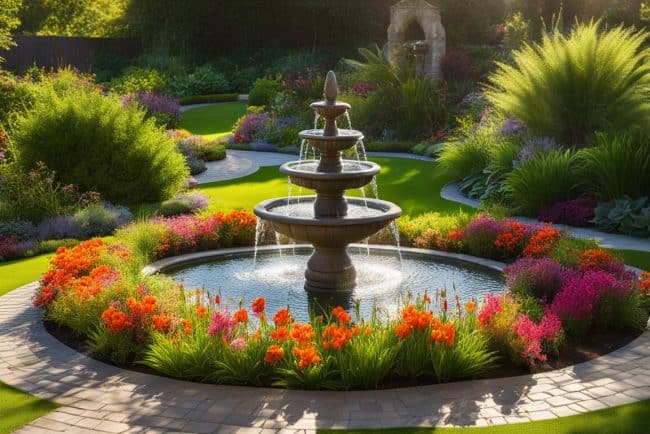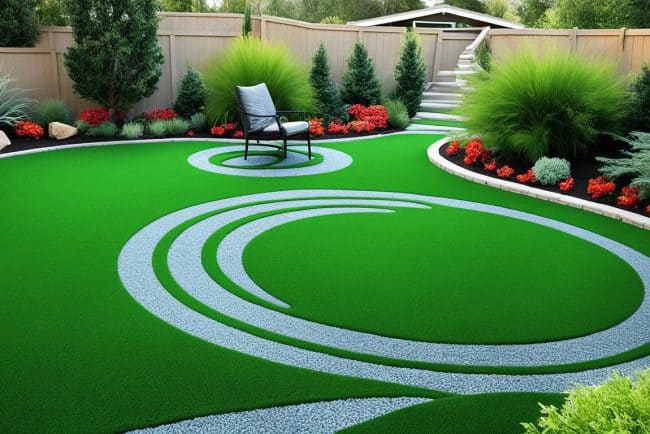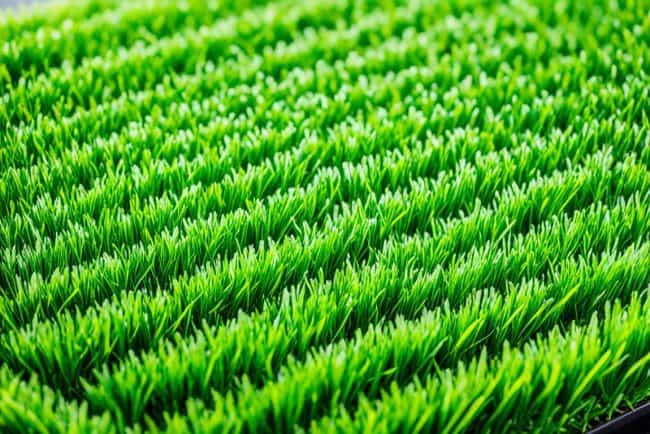
Did you know installing artificial grass can save up to 55 gallons of water per square foot each year? This fact shows the growing trend of eco-friendly outdoor spaces among homeowners. They are looking for sustainable ways to landscape. Artificial grass ensures a lush, green lawn all year with little to no maintenance. No need for constant watering, mowing, or fertilizing. I chose artificial grass and now have a beautiful, easy-care lawn. It looks good and is good for the planet. In this article, we will look at the main features and benefits of artificial grass. We’ll see how it helps make outdoor spaces more eco-friendly.
Key Takeaways
- Artificial grass provides a lush green lawn year-round, reducing maintenance efforts.
- It eliminates the need for excessive watering, saving significant amounts of water.
- The durable nature of artificial grass makes it ideal for high-traffic areas.
- Using artificial turf helps minimize carbon emissions associated with lawn care.
- Artificial grass integrates well with hardscaping elements for enhanced outdoor functionality.
Introduction to Eco-Friendly Outdoor Spaces
Eco-friendly outdoor spaces are more than just pretty gardens. They mix beauty with sustainability. Homeowners now prefer green lawn choices for their yards and the Earth.
About 44% of Americans really care about our environment. Another 27% are quite concerned. This has led to a big interest in sustainable gardening and smarter landscaping.
Having an eco-friendly yard means choosing native plants. These plants don’t need much water and welcome local animals. This helps all kinds of life to thrive.
We also use long-lasting, sustainable materials like composite decking. And we love recycling. I’m all for saving water and money with rainwater harvesting.
Solar lights and LED bulbs are great for eco-friendly lighting. Buying second-hand outdoor furniture also helps cut down waste. And using recycled wood and plastic is a big plus.
Composting and eco-friendly products reduce landfill waste and enrich the soil. Repurposing items as decor means fewer new things are needed. Choosing certified wood products helps protect forests too.
Knowing about eco-friendly outdoor spaces helps our planet. This way, we get beauty and sustainability all in one place. It’s about enjoying the outdoors responsibly.
Key Features of Artificial Grass
Artificial grass has many great features, making it eco-friendly for outdoors. It fits well in both homes and businesses. It’s adaptable and has lots of benefits.
This kind of grass is made from safe materials like soybean oil. It’s good for people and animals too.
One big plus is its softness, often at 35mm. This makes it nice for playing or just relaxing.
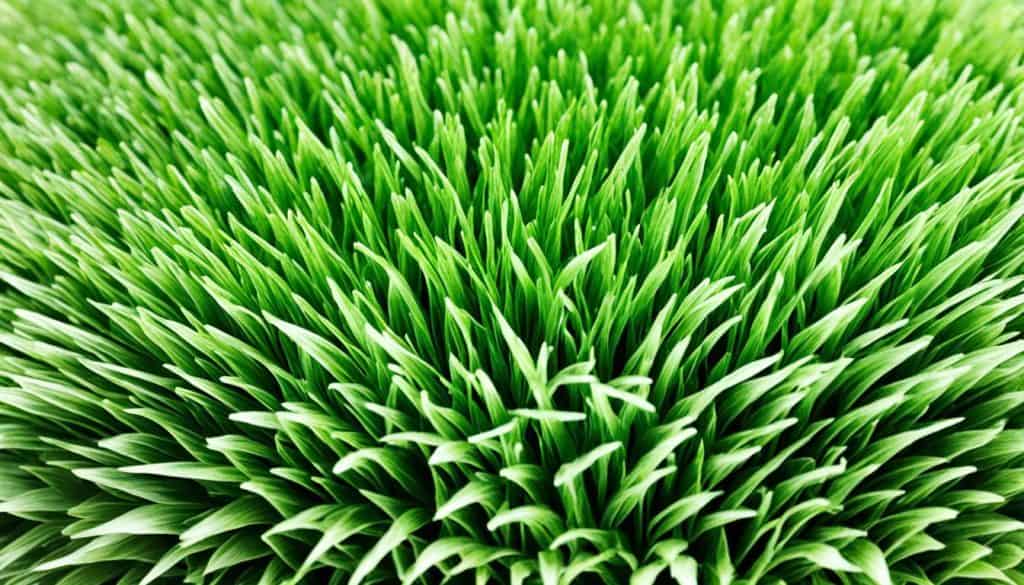
Synthetic grass looks real because it uses two shades of green. It stays nice and green all year. It’s both pretty and practical.
It’s also 100% recyclable, which is great for the planet. This matches well with goals to protect the environment.
Many kinds of artificial grass come with up to eight years of warranty. This shows they are made to last.
Overall, artificial grass is attractive because it’s environmentally friendly. It’s good for green landscaping.
| Feature | Description |
|---|---|
| Material | Non-toxic, often with renewable components such as soybean oil. |
| Softness | 35mm surface offers exceptional comfort for various activities. |
| Aesthetic | Dual-color yarns replicate the lush appearance of natural grass. |
| Recyclability | 100% recyclable components at the end of the lifespan. |
| Warranty | Warranties up to eight years ensure high-quality performance. |
Benefits of Choosing Eco-Friendly Artificial Grass
Eco-friendly artificial grass offers many benefits for outdoor areas. It helps save water and requires little care. These features make living green easier and help people act more sustainably.
Water Conservation
Eco-friendly artificial grass aids in saving water. It needs much less water than real grass. Homeowners can save up to 22,000 gallons of water yearly by switching. This is key in areas with little water and helps protect the environment.
Low Maintenance Requirements
This grass also needs less upkeep. There’s no need for mowing, fertilizers, or chemicals. You’ll just occasionally remove debris or brush the grass. It’s strong and can last for up to 25 years. This means more beauty and less work for your yard. It makes keeping a beautiful lawn easy and stress-free.
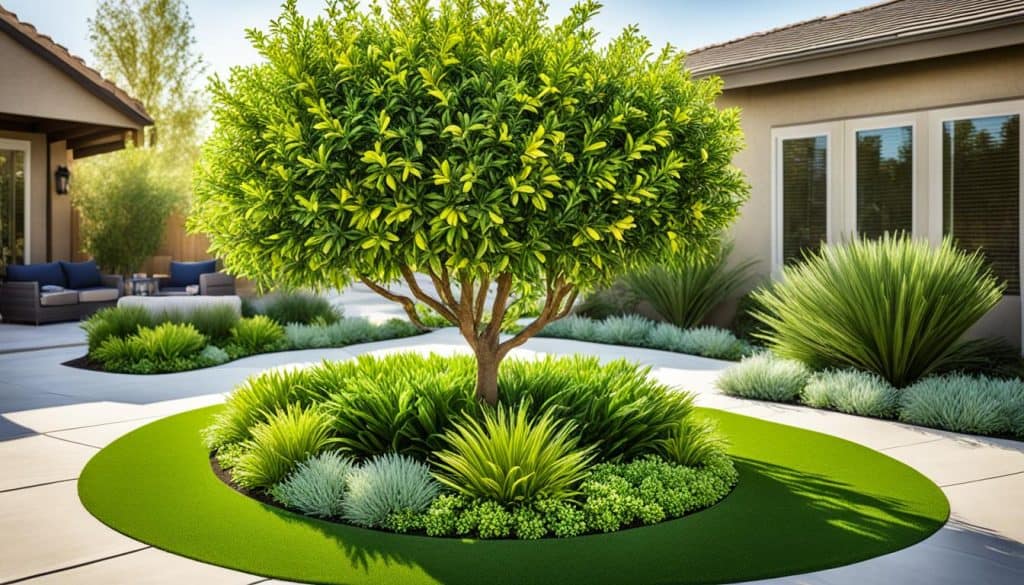
The Role of Artificial Grass in Sustainable Landscaping
Artificial grass helps make landscaping sustainable. It cuts down how much water we use, saving a lot from irrigation. Traditional lawns drink up about 55 gallons of water per square foot every year. But synthetic turf needs no water, offering big savings.
Another perk of artificial grass is it gets rid of the need for harmful fertilizers and pesticides. These chemicals often end up in local waters, hurting ecosystems. By choosing synthetic turf, we help keep our biodiversity and stop the bad effects of lawn chemicals.
Artificial grass also reduces our carbon footprint. Less work for gas-powered lawn tools means fewer greenhouse gases. For example, using a gas lawn mower for an hour is like having 11 cars on the road for the same time. So, synthetic grass is not just kinder to the planet but also keeps our air cleaner.
This type of grass lasts a long time—10 to 15 years—which cuts down environmental harm. It’s often made from recyclable materials, making it even better for the planet.
Synthetic turf is also a safe place for sports and play. It doesn’t need much upkeep, which means less use of fossil fuels. This helps keep the air cleaner and reduces noise from lawn care.
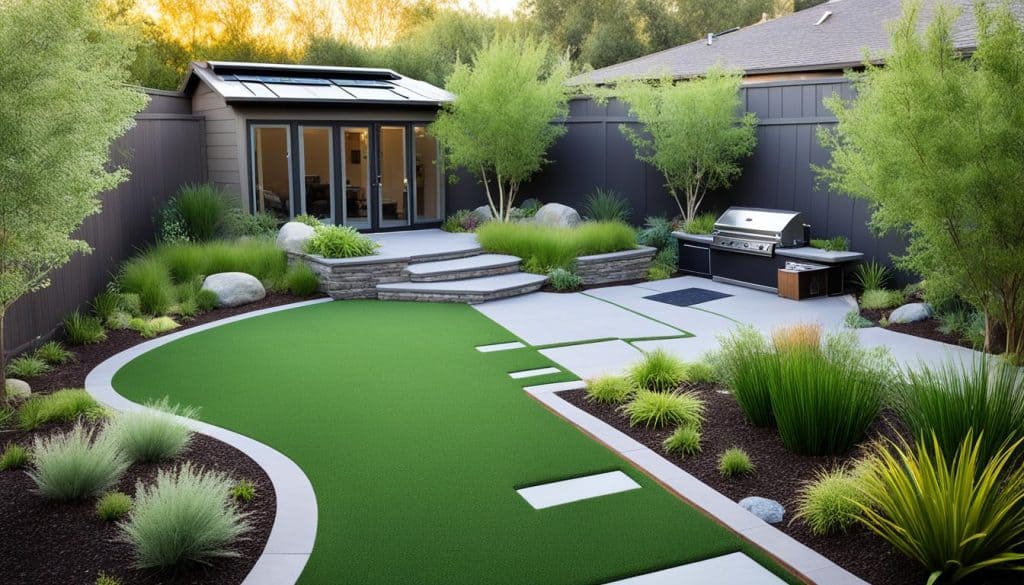
| Aspect | Traditional Lawns | Synthetic Turf |
|---|---|---|
| Water Requirement | 55 gallons per sq ft annually | No watering needed |
| Fertilizer/Pesticide Use | Required | Not needed |
| Carbon Footprint | High due to equipment use | Reduced emissions |
| Maintenance Frequency | Regular reseeding/repairs | Low maintenance |
| Lifespan | Shorter (3-7 years) | 10-15 years |
Overall, using artificial grass for landscaping means we’re caring for the environment. It also brings benefits that last a long time for homes and communities.
Creating an Eco-Friendly Outdoor Space with Artificial Grass
Using artificial grass for your outdoor space is eco-friendly and lowers maintenance work. The installation process needs to be done carefully to make the turf last longer and perform well. By following a clear plan, you can achieve great results that meet the goal of creating an environment-friendly outdoor area.
Installation Process
First, clear the existing grass and debris from the area. Next, lay a base of crushed rock or gravel to stabilize the ground. Roll out the turf and use staples to secure it firmly.
Then, add infill material for extra stability and to ensure the surface is even and strong. This step makes the grass ready for various outdoor uses, becoming a top choice for many.
Maintenance Tips for Longevity
Regular care keeps artificial grass looking fresh. Brush the blades often to keep them upright. It’s also important to remove debris to avoid buildup on the turf’s surface.
Occasionally rinse the grass to keep it fresh. If there are spills, clean them with a gentle detergent and rinse well. This will prevent any stains or odors. Following these tips helps keep your artificial grass beautiful and functional for years.
Cost-Effectiveness and Long-Term Savings
When we talk about artificial grass, it’s important to see its financial pluses over time. Sure, it costs more upfront than regular lawns. But, the savings shine as maintenance expenses plummet. Homeowners see big cuts in water bills because artificial grass doesn’t need watering. This fits right in with eco-friendly trends.
Artificial grass means saying goodbye to gas lawn mowers, fertilizers, and pesticides. This cuts down on maintenance costs. An artificial lawn looks great without the hard work, saving money over time. These benefits make artificial grass a smart money move.
Parks and recreation places help local communities, too. In 2019, they brought in about $218 billion in economic activity in the U.S. This shows how eco-friendly choices have broader positive money impacts. It shows that investing in sustainable landscaping saves money in the long run. This encourages more eco-friendly choices.
| Investment Type | Upfront Cost | Long-Term Savings |
|---|---|---|
| Traditional Lawn | Moderate | Maintenance costs, water bills, fertilizers |
| Artificial Grass | Higher | Significant savings on maintenance and water bills |
In summary, artificial grass stands up to time and cuts down on care. This makes it an eco-smart and cost-smart choice. It’s a win for the environment and wallets alike. Choosing artificial grass is a smart move for lasting savings. It’s perfect for anyone wanting to make their outdoor space better.
Conclusion
Choosing artificial grass has changed the way I view my outdoor space. It looks good and helps the planet. By using artificial grass, I save water and cut down on upkeep. This helps me live more sustainably.
Artificial grass cuts my water use, saving money and the environment. It works well with other water-saving plans. It also means a healthier place for plants and animals. I don’t need harmful chemicals to keep it looking good.
This choice improves my yard and helps the earth. It keeps up with eco-friendly trends. Investing in artificial grass is good now and for my property’s future value. It shows my deep commitment to a greener tomorrow.
